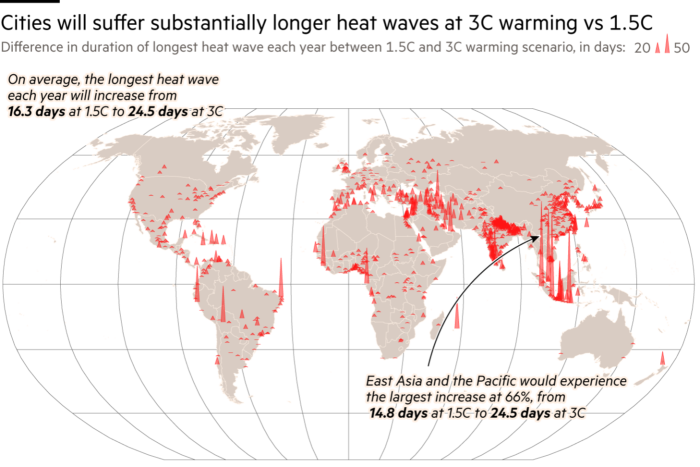Energy demand for cooling in global cities to soar, says report

Stay informed with free updates
Simply sign up to the Climate change myFT Digest — delivered directly to your inbox.
World cities will face longer heatwaves, greater disease risk and “skyrocketing” energy demand for cooling, according to a new report on post-industrial global warming of 1.5C to 3C, which the planet is on track to reach.
While low-income cities were likely to be the hardest hit, developed global centres including Tokyo, Rome, Madrid, Rio de Janeiro, Beijing, Sydney, London and New York were also likely to be severely affected.

For most cities the difference will be substantial, with increased rainfall, heat and droughts rising in severity and frequency, the report by the World Resources Institute found.
The report analysed climate hazards using downscaled global models for 996 of the largest cities — home to 2.1bn people, or more than a quarter of the world’s population.
The world has already warmed by at least 1.1C since pre-industrial times, a body of UN scientists has found, and exceeded 1.5C in the past 12 months. Scientists track the temperature rise over at least one or two decades, however.
“The difference between 1.5C and 3C has life or death consequences for billions of people worldwide,” said Rogier van den Berg, global director at the WRI Ross Center for Sustainable Cities.
The findings were a “wake-up call to every city and national government leader: now is the time to start preparing cities for a much hotter world, while doing everything we can to slash [greenhouse gas] emissions,” he said.
The World Meteorological Organization has forecast that 2024 will be the warmest year on record. UN scientists say that on the current trajectory the world is likely to breach 1.5C by the mid-2030s.
At 1.5C above pre-industrial levels, the longest heatwave each year would last on average 16.3 days. At 3C, however, this would jump to 24.5 days, with 16 per cent of the world’s largest cities experiencing at least one heatwave lasting over a month each year, according to the WRI data.
In the Middle East and north Africa, the longest heatwaves would extend by 13.6 days on average, lasting 36.3 days.
Heatwaves would also become more frequent. On average cities would see a 29 per cent increase in the number of heatwaves, while in low-income countries this could climb by 45 per cent.
The report highlights that the demand for energy-intensive air-conditioning will also surge as more people are exposed to long periods of hot weather.
At 3C warming about 194mn city dwellers will see a doubling of cooling demand, compared with 8.7mn people at 1.5C, it estimates.
The spike in demand would pose particular challenges to cities with previously temperate climates in northern parts of Europe, as well as in lower-income urban areas, where there is less air-conditioning installed.
Longer droughts combined with short, but more extreme rainfall events in some regions had the potential to devastate agriculture and infrastructure, the report said, putting strain on food chains.
“This research makes it clear that we can’t afford to delay action on climate change any longer, as dire consequences await cities in a 3 degrees C world,” said Antha Williams, who leads the Bloomberg Philanthropies’ environment programme.
Climate Capital

Where climate change meets business, markets and politics. Explore the FT’s coverage here.
Are you curious about the FT’s environmental sustainability commitments? Find out more about our science-based targets here
#Energy #demand #cooling #global #cities #soar #report








